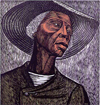How Nell Irvin Painter Illustrated Creating Black Americans
Nell Irvin Painter’s Creating Black Americans is destined to become one of the most beautiful history textbooks in recent memory, with roughly 150 creative representations of the African-American experience ranging from painting and sculpture to graffiti art and quilts. Most of the images are in stunning color, some of them filling an entire page. (I’ve done what I can to show the sample images in this post in the best light while keeping bandwidth low, but they don’t do the printed versions justice.) I asked Prof. Painter, who only recently retired from teaching after running Princeton’s African-American History department, how she chose the images to accompany her work.
Creating Black Americans works beautifully as a finished product, but I was feeling my way as I wrote. You see, I’m an American historian, not an art historian. So most of my preparation went into the narrative text, into the job of getting the history right. Even so, over time, dealing with the images grew into a bigger and bigger task. Toward the end of the work, permissions demanded what seemed like an infinity of time: tracking down artists or their agents or their executors, and getting them to reply with permission and usable images. That was how my work with illustrations ended. It started with my deciding which art to use.
I had begun with the decision to relate the illustrations to the major theme of the book: black people’s own creativity. That meant that all the artists would be African-American. Then there was the fundamental fact that Creating Black Americans is a history book. The artwork had to relate to historical themes in African-American history. Those two imperatives separate Creating Black Americans from art history, despite my book’s wealth of art.
Even within those limitations, I found much more art than I could use, except in three chapters. The themes of the Atlantic slave trade, the Civil War, and Reconstruction have not yet produced the gorgeous abundance of more favored themes such as ordinary working people and racial violence. Two examples from my book are Elizabeth Catlett’s “Sharecropper” (1968, left) and David Hammons’s “Injustice Case” (1970, right).
29 November 2005 | guest authors |
How Karen Olsson Discovered The Gay Place
A month or so ago, I read an entertaining essay by Chris Lehmann in which he suggested that “the one truly great modern American political novel” wasn’t All the King’s Men but The Gay Place. I filed the title away for future reference…and dang if not a few days later, the NYTBR was devoting the first two paragraphs of its review of Karen Olsson’s Waterloo to The Gay Place and its author, Billy Lee Brammer. Well, I thought, this is the sort of thing that leads to Beatrice guest essays…
I’d never heard of Billy Lee Brammer’s 1961 trilogy The Gay Place before I moved to Austin, but I came across it soon enough. A friend from college, turned graduate student at the University of Texas, was serving as a teaching assistant in a Southwestern U.S. Lit class that had Brammer’s book on the syllabus. When I found it on his shelf, he explained that the book was not about gay people, as outsiders commonly assume, but about affairs both political and (hetero)sexual, in a 1950s state capital closely based on Austin. (The title comes from an F. Scott Fitzgerald verse: “I heard Helena/ In a haunted doze/ Say: “I know a gay place/ Nobody knows.”) To me that sounded quaint and provincial; I probably made a face. No no, he told me, it was actually pretty good.
I can no longer really remember my first reaction to The Gay Place, because I’ve reread it several times since then, but I do know that I loved it. It consists of three short novels, totaling over five hundred pages, linked by setting and by the character of Governor Arthur “Goddamn” Fenstemaker, an LBJ/Huey Long-style good old boy who strides in and out of the narrative, pulling at his nose and drinking and cursing and pushing the plot along. Brammer greatly admired Fitzgerald, and his prose has a lyrical bent, but he also admired Lyndon Johnson, and the book’s more fanciful turns of phrase are tempered with Fenstemaker’s cursing. Likewise, the mooning passive quality of some of his characters plays against Fenstemaker’s machinations. For me (transplant that I am) that mix of romanticism and salt-of-the-earthiness captures something essential about the character of Texas itself—which was the subject of Brammer’s memorable first lines: “The country is barbarously large and final. It is too much country—boondock country—alternately drab and dazzling, spectral and remote. It is so wrongfully muddled and various that it is difficult to conceive of it as all of a piece.”
28 November 2005 | guest authors |


 Our Endless and Proper Work is my new book with Belt Publishing about starting (and sticking to) a productive writing practice.
Our Endless and Proper Work is my new book with Belt Publishing about starting (and sticking to) a productive writing practice. 
